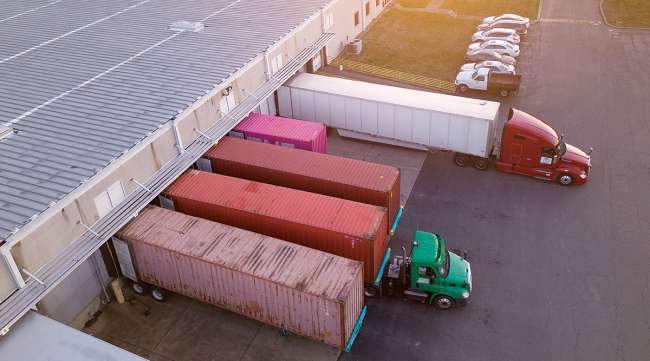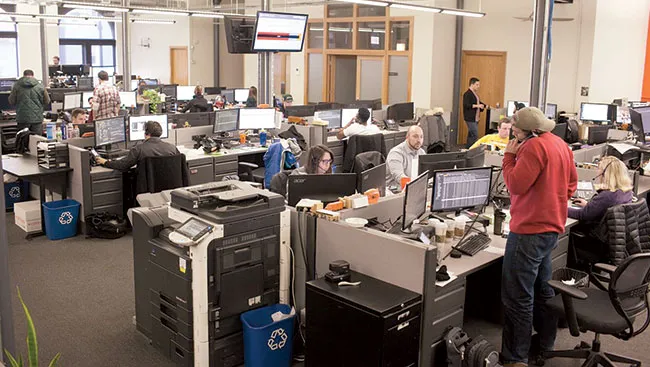Managing Editor, Features and Multimedia
When Will Freight Market Conditions Improve?

[Stay on top of transportation news: Get TTNews in your inbox.]
Stubbornly weak freight market conditions have been placing financial strain on third-party logistics companies for the past couple of years with an oversupply of truck capacity driving down rates and squeezing brokers’ margins.
This challenging business environment for 3PLs has persisted into early 2024 as logistics providers eagerly await a market rebound that many hope will arrive at some point this year.
For now, though, the question remains: When will the market turn?
“Right now, there’s still excess capacity and until that right-sizes, we won’t see that turnaround that we all want,” said Kendra Phillips, vice president and general manager of transportation management and freight brokerage at Ryder System Inc.
Nonetheless, Phillips said she expects 2024 to be a “steady year” for the transportation industry, making it an ideal time for 3PLs to prepare themselves for the eventual freight market recovery.
“We need to be making the right investments in tech, we need to be implementing that tech, and we need to be setting ourselves up to be there to drive success for our shippers when freight rates do go up,” Phillips said. “Right now is our year to take a step back, take a deep breath and position ourselves appropriately in the market.”
Glancing in the rearview mirror, the final quarter of 2023 stood out as the toughest period of a tough year, according to Transportation Intermediaries Association’s latest 3PL market report.
►Amazon Takes No. 1 Spot on Top 100 List
►When Will Freight Market Conditions Improve?
►Map: Where the Top 100 Are
►Armstrong: A Year to Forget for 3PLs
►Logistics Market Faces Challenges Across Segments
Sector Rankings
Freight Brokerage | Dedicated
Dry Storage Warehousing
Refrigerated Warehousing
Ocean Freight | Airfreight
During the fourth quarter, the 3PL industry experienced a 4.7% decline in shipments, a 4.3% decrease in invoice amount per shipment and an 8.8% drop in total revenue compared with the third quarter, the report found.
Average gross margin percentage during the fourth quarter stood at 15.6%, up slightly on a quarter-to-quarter basis but still well below year-ago levels.
“The headwinds were there in every single category, from loads to invoice per load and for small, medium and large brokers,” said Anne Reinke, TIA’s president and CEO. “The only thing that’s somewhat of a bright spot is our gross margins were a little bit stabilized, and LTL showed less weakness than, say, truckload.”
She agreed that the freight market downturn has been driven by excess freight capacity compared with freight volumes.
Many new carriers entered the marketplace during the surge in freight demand powered by the economic recovery from the pandemic, but some of those businesses shut down as freight rates deteriorated. More than 35,000 carriers have exited the industry in the past year and a half, TIA said.
Some brokers also have been closing their doors or merging with other companies in this down cycle for the freight market.
As of Jan. 26, a total of 28,436 freight brokers were registered with the U.S. Federal Motor Carrier Safety Administration, down from 31,187 in Dec. 30, 2022, according to TIA.
Load board operator and market intelligence firm DAT Freight & Analytics also reported difficult market conditions for freight brokers.
Contract rates, which had been buoying brokers’ margins, came down as that freight was rebid, especially in the second half of last year, said Ken Adamo, DAT’s chief of analytics.
“They weren’t making much money on the spot market, they weren’t making as much money on the contract market, and it just really crunched their bottom line,” Adamo said.
A recent DAT study found that freight brokers’ average gross margin — the percentage of revenue remaining after paying the carrier — was just under 13.5% in 2023. Broker margins were weakest in the dry van segment at just over 13%. Flatbed loads commanded the highest margin at more than 15.1%, followed by refrigerated at 13.8%.
Adamo expressed some measured optimism about the year ahead, predicting that transportation providers will begin to feel some tailwinds in the second quarter.

Freight brokerages have been investing in technology to improve their services and better position themselves for when the freight market rebounds. (Redwood Logistics)
“I think we’ll see a market largely pointed toward recovery by mid to late Q2, and I think we’ll have a pretty good Q3 this year,” he said.
In the meantime, more mergers and acquisitions may be coming to the 3PL space.
“I think consolidation is certainly still on the menu,” Adamo said. “This is when the larger brokers typically go shopping.”
Freight brokers also are expanding their services and capabilities to better position themselves for the future.
“I think you’re going to continue to see diversification of service offerings,” Adamo said. “You’re seeing smaller and smaller brokerages offering managed transportation and other value-added services, diversifying into less-than-truckload and intermodal and just finding ways to insulate themselves from the yo-yo that is dry van trucking.”
Adamo said other issues that could affect brokers in the year ahead include upcoming regulation on truck speed limiters and California’s Assembly Bill 5, a worker classification law that challenges the trucking industry’s independent contractor model.
Navigating a Down Market
Despite the current weakness of the freight market, the industry’s top logistics providers continue to find ways to serve their customers and support their carrier partners while still turning a profit.
TIA’s Reinke said the 3PLs that have best navigated the downturn tend to be very intentional about the market niche they serve while remaining cautious about growth.
“They don’t overexpand during the good times so they don’t have to retrench during bad times,” she said.
The most successful 3PLs also focus on building and maintaining their business relationships with shippers and carriers alike, she said.
Carriers and brokers have both been dealing with difficult market conditions, making it more important than ever for asset-based and non-asset-based companies to overcome some of the inherent distrust in this business and find better ways to work together for the benefit of both parties.
Volvo's Chayene de Souza and Magnus Gustafson discuss how new, connected trucks can boost business, enhance safety practices, and reinforce preventative maintenance plans. Tune in above or by going to RoadSigns.ttnews.com.
“When we are both not doing as well as we have in the past, there’s an opportunity to have that discussion,” Reinke said.
Freight brokers’ success ultimately hinges on their flexibility, said Billy Hart, managing partner at Bluejay Advisors, an investment bank and consultancy focused on mergers and acquisitions in the transportation and logistics industry.
While brokers can aggregate capacity for their shipper clients, their key market advantage against asset-based competitors and other modes of transportation comes down to their ability to adjust to fluctuations in freight demand.
Compared with an asset-based carrier, it’s much easier for a 3PL to adjust when a manufacturing facility ramps up its freight volumes from 10 loads per day to 20, for example, Hart said.
“The 3PLs that are going to be able to service the shippers in a flexible way and also be able to improve utilization, whether that be through technology, through processes or through understanding of their customers’ freight flows, and then be able to match that capacity elegantly, quickly, in a very flexible manner, and at scale, are the ones that are going to win,” he said.
Even at times when freight capacity is loose, brokers’ relationships with carriers are pivotal, Hart said. The freight brokers that are in the best position to succeed are those that build business partnerships with carriers that extend beyond one-off transactions.
“If I’m a carrier and I’m relying on a broker for freight, it’s not really my first choice unless you are helping me run my business better,” Hart said. “You’re going to get me from point A to point B, but you’re not going to leave me there. You’re going to reload me and get me from point B to C and back to A.”
Right now is our year to take a step back, take a deep breath and position ourselves appropriately in the market.
Kendra Phillips, Ryder System
Image
Looking back at the past several years, the pandemic exposed weaknesses in the supply chain and the need for greater freight visibility and business intelligence, Ryder’s Phillips said.
“COVID forced massive improvement already,” she said. “It’s already night-and-day different. We have visibility now.”
Basic track and trace capabilities, which some carriers have resisted in the past, are now a baseline expectation for many shippers.
Looking ahead, Phillips pointed to opportunities for the industry to harness artificial intelligence and market data to make better pricing decisions for both contract and spot freight.
She also said 3PLs can build stronger relationships with their carriers by better understanding where they have underutilized assets or need backhaul freight.
“The market will get tight again and carriers will have power again,” she said. “How are we fostering our carrier relationships so when that happens, our shippers are still able to move their freight successfully?”
Ryder’s Supply Chain Solutions business, which provides logistics services ranging from dedicated transportation to supply chain management and e-commerce fulfillment, ranks No. 8 on the Transport Topics Top 100 list of the largest logistics firms in North America. The business segment reported $173 million in revenue from freight brokerage services in 2023.
Supply Chain Resilience
To mitigate future supply chain disruptions, inventory imbalances and rising costs, logistics providers will need to become more flexible and form closer partnerships with their customers and carriers, several major 3PLs said during a panel discussion at the Manifest 2024 logistics and supply chain conference in February.

From left, panel moderator and Maergo CEO Mark Lavelle, Stephen Beard of PFS, Grady Martin of Saddle Creek Logistics, Flexport’s Parisa Sadrzadeh and Ryder’s Jeff Wolpov discuss supply chain trends at Manifest 2024 in Las Vegas. (Seth Clevenger/Transport Topics)
“I think the name of the game this year — and moving forward — is resilience and agility,” said Parisa Sadrzadeh, executive vice president of SMB and omnichannel fulfillment at logistics and supply chain management firm Flexport.
The global pandemic and its far-reaching ripple effects created numerous challenges for the logistics industry, she added.
“The biggest thing that it taught us is that supply chain technology is just not where it needs to be,” Sadrzadeh said. “There are too many gaps. We haven’t digitized enough of the supply chain.”
Flexport ranks No. 42 on the logistics TT100.
It’s more important than ever for logistics providers to have thoughtful dialogue with their clients to help solve their growing transportation challenges, said Stephen Beard, vice president of transportation at PFS, an e-commerce fulfillment provider focused on luxury brands.
“This is the time, for us in the 3PL world, when we earn our keep,” Beard said. “If this was easy, our clients would do it themselves. … They need us. This is where we’ve got to shine.”
PFS was acquired in October by contract logistics firm GXO, which ranks No. 5 on the logistics TT100.
Jeff Wolpov, senior vice president of e-commerce at Ryder System, said the industry experienced both a freight and warehousing recession last year.
I think we’ll see a market largely pointed toward recovery by mid to late Q2, and I think we’ll have a pretty good Q3 this year
Ken Adamo, DAT Freight & Analytics
Image
At the same time, labor costs and rent increased significantly for the warehousing sector, which also continued to face inventory imbalances, he said.
“People still had the wrong goods in the wrong place at the wrong time,” Wolpov said. “The lesson learned is we’ve just got to continue to do more with less. We’ve got to continue to get more efficient and more effective to continue to delight our customers’ customers.”
Speed Versus Sustainability
A growing number of shippers and consumers have been pushing logistics and fulfillment providers to offer faster delivery of products ordered online, especially as consumers have become accustomed to next-day or even same-day home delivery through Amazon.com.
“What Amazon does is a super high bar,” Flexport’s Sadrzadeh said. “It’s only going to continue to rise, and it’s important for us to start to rise to it.”
While same-day delivery may represent the leading edge of e-commerce fulfillment, most customers don’t require that level of service right now, said Grady Martin, senior vice president of innovation and engineering at Saddle Creek Logistics.
Instead, their top priority is reliably hitting the expected delivery window.
“It’s meeting what you promised them,” Martin said. “If you tell them four days, it’s four days. That’s a lot more critical now for a lot of our clients.”
Saddle Creek Logistics, based in Lakeland, Fla., ranks No. 57 on the logistics TT100.
At the same time, shippers are increasingly tasking their logistics providers with improving environmental sustainability.
“It’s coming up more frequently, and with a little more passion, from certain brands,” Beard of PFS said.
Unfortunately, the push to reduce waste and emissions often runs counter to the drive for faster delivery.
“Those two are miles apart,” Beard said. “The faster you want to go, generally speaking, the more carbon footprint that you create.”
Want more news? Listen to today's daily briefing above or go here for more info
He predicted that retailers may begin presenting information about an order’s carbon footprint alongside the cost when offering delivery options at checkout and giving customers choices such as deferred delivery certified as carbon neutral.
There also are instances where speed and sustainability are in alignment, Beard added.
“The biggest thing you can do as a shipper to reduce your carbon footprint is to re-evaluate your packaging,” he said. “Cube kills, and so much air is being shipped — just air inside a box. Eliminating that packaging-related waste will reduce both costs and carbon emissions,” Beard said. “That’s the low-hanging fruit. We better be doing that.”
Sadrzadeh said Flexport aims to reduce environmental impact by creating more nimble supply chains and better inventory management by better utilizing data, including through artificial intelligence.
“Some of the AI we already have in our systems today helps shippers be much more thoughtful, for instance, on how to plan for the movement of your goods across the ocean so that you’re not rush shipping something on an airplane when you could have done it on ocean if we had helped you prepare for it better.”








